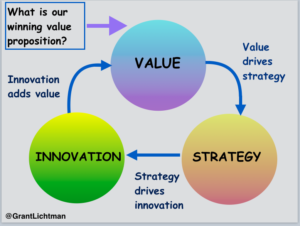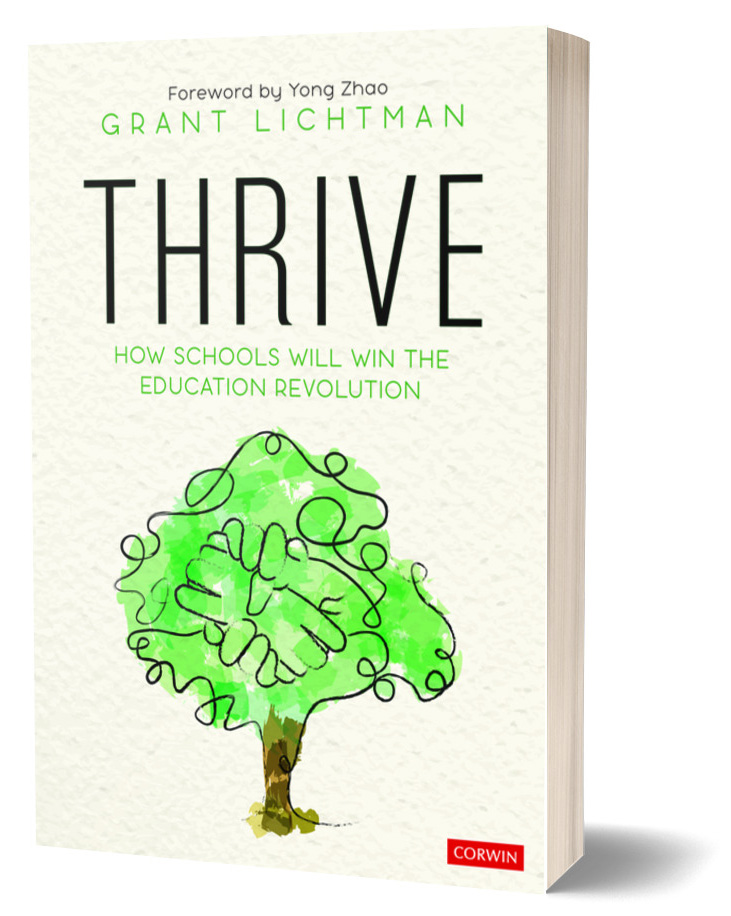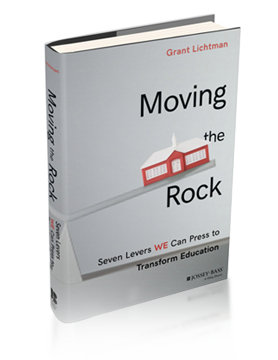Our colleague Miguel Guhlin started a good discussion on Twitter and in his blog post about so-called innovative practices in K-12. Miguel was prompted by an article by Mike Schmoker that questions if “innovations” like design thinking and makerspaces actually improve learning more than time-tested, research-proven activities.
My response: Yes, and! By definition, innovation leads to better learning in schools.

Value-innovation-strategy flow from THRIVE: How Schools Will Win the Education Revolution (Lichtman, 2019)
First, let’s define “innovation”. Innovation is NOT about having or testing any great idea. Innovation is about implementing ideas or practices that bring or raise value to your organization. In the case of schools (I HOPE we can all agree), value is increased when students learn better. Therefore, changes in practice that result in better learning are innovative and those that don’t are not. The 3D printer is not an innovation; it is just a 3D printer until it is used in a way that routinely results in better learning outcomes. (This understanding of what innovation really is, and how it relates to the strategies your school undertakes and the value you offer to your families, lies at the very heart of my new book, THRIVE: How Schools Will Win the Education Revolution.)
We also should all be able to agree that learning is always enhanced by higher degrees of student engagement. This is Dewey 101, and it is the root of what we are now calling “deeper learning”. When students are more deeply engaged, they are going to learn better.
A few years ago I did a rough trawl through Edutopia articles and blogs and synthesized a list of simple classroom practices that teachers are using to boost student engagement, to build a “deeper learning” experience. I have shared and used my “Deeper Learning Cheat Sheet” many times, asking teachers to pick one or two of the elements that resonate with them and just try them. None of these take huge permission from others and none of them violate good standards of teaching. Universally the response has been, “I can do that”, and, if implemented, these teachers will have launched a classroom “innovation”.
Do I have detailed research to prove that each of these changes in practice lead to better learning? No. And yet I have never had a single educator suggest that any of these would NOT lead to better learning outcomes for more students. So you decide: wait for the 20 year longitudinal study that proves that more highly-engaged students learn better, and that each of the elements on the Cheat Sheet can contribute, or think for yourself and just do it!
There is a role in learning for worksheets, quizzes, standardized tests, Powerpoint lectures, and the rest of what we think of as a traditional classroom. But there is also a role for “not” those things. A great teacher creates the conditions whereby her students understand that what they think of as “boring” are necessary because they want to learn, because they are engaged through ownership and relevancy of the learning arc. I am not saying that the pedagogical elements on the Cheat Sheet are the goal of teaching, but they are a heck of a good start.
Disagree? Please comment! Let’s have this discussion!













Leave A Comment